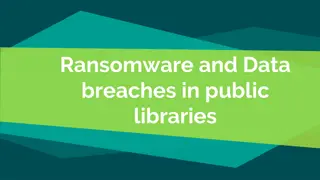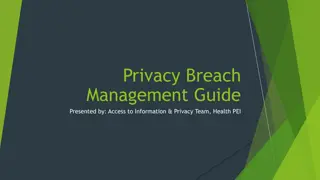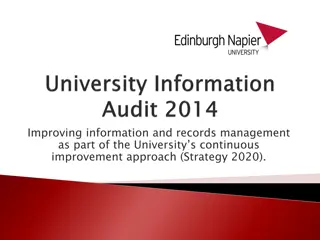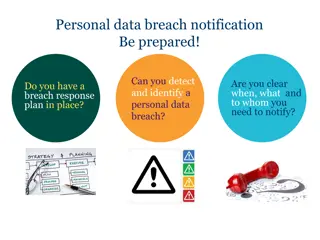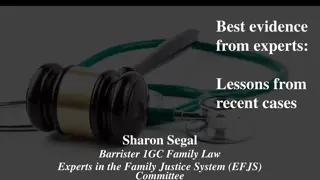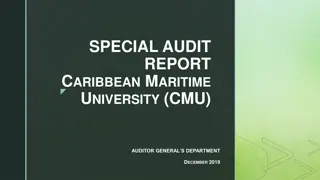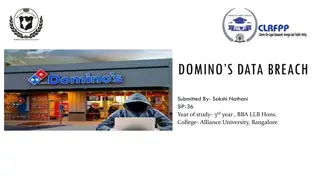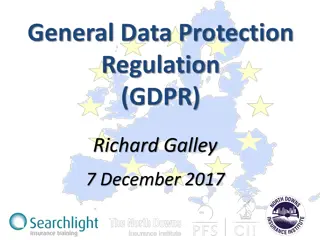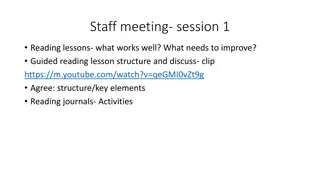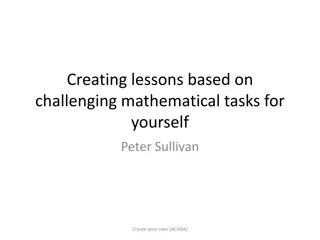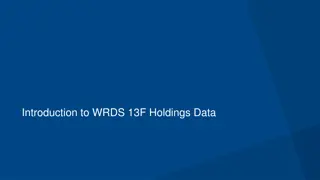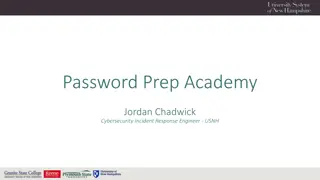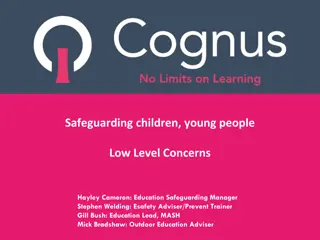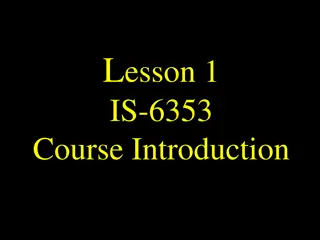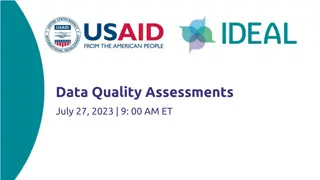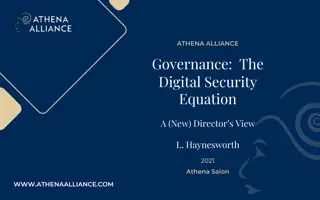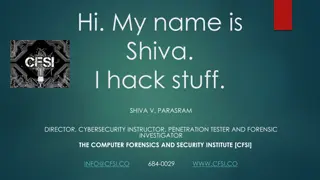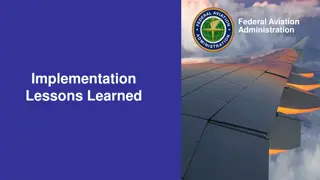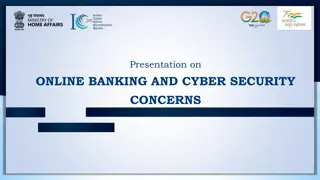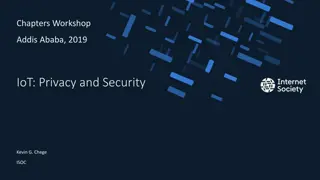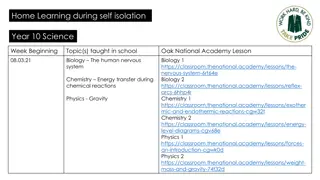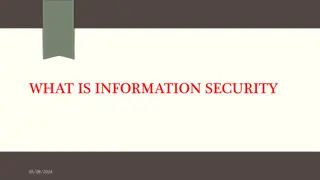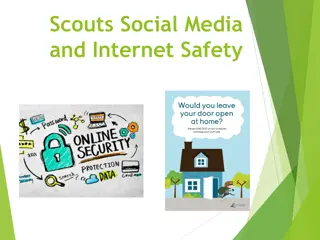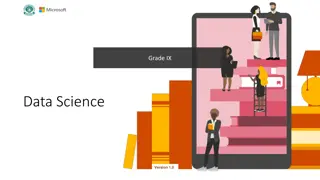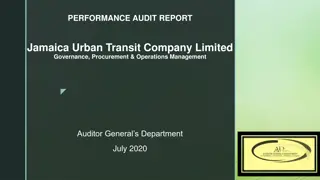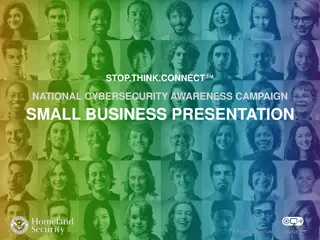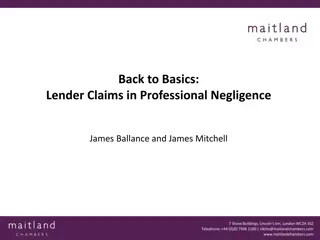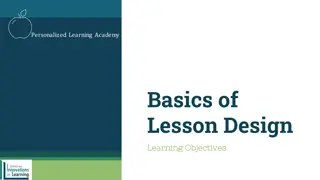Lessons from Recent Data Breaches: Insights and Strategies
This presentation covers the landscape of data breaches, leading causes, and steps to take when facing a cyber incident. It discusses the impact of large-scale cyber attacks by external threat actors, outlines key considerations for response, and provides tips for notifying affected individuals to minimize harm and rebuild trust.
Download Presentation

Please find below an Image/Link to download the presentation.
The content on the website is provided AS IS for your information and personal use only. It may not be sold, licensed, or shared on other websites without obtaining consent from the author. Download presentation by click this link. If you encounter any issues during the download, it is possible that the publisher has removed the file from their server.
E N D
Presentation Transcript
Lessons from recent data breaches Presenters Andrew Campbell | Senior Privacy Adviser & Conciliator Anique Owen | Senior Privacy Adviser & Conciliator
2 Data breach landscape A data breach occurs where personal or sensitive information is subject to misuse, loss or unauthorised access, modification or disclosure. Freedom of Information | Privacy | Data Protection
3 Leading causes of data breaches notified to OVIC Large scale cyber attacks by external threat actors. Human error. Internal processes, technology and access controls. Freedom of Information | Privacy | Data Protection
4 Large scale cyber attacks by external threat actors Cyber attacks accounted for 11% of incidents notified to OVIC between 1 January and 30 June 2022. Freedom of Information | Privacy | Data Protection
5 Scenario It s Wednesday afternoon and you are informed of a cyber incident at your organisation. A staff member has clicked on a link in an email that turned out to be a phishing attack. As a result, a threat actor has been able to access your network using the staff members credentials and has downloaded the personal information of over 7,000 individuals including: full names, email address, phone number and residential address. Your organisation has immediately taken steps to contain the incident and prevent any further compromise of data and convened its incident response team. Freedom of Information | Privacy | Data Protection
6 What to consider when you ve suffered a large scale cyber attack How did it happen? Do you need immediate assistance through the Cyber Incident Response Service (CIRS)? What personal information has been accessed? Who is impacted? How many people are likely to be affected? Are any services impacted? What other information has been accessed? Has the information been exfiltrated? Has the information been published on the dark web or internet? Should we notify affected persons? When is the right time to notify affected persons? What is the risk to the individuals? Freedom of Information | Privacy | Data Protection
7 Tips for notifying affected persons following a cyber attack Notifying people that there has been a breach allows them to take action to reduce the risk of harm. You may have an ongoing interaction with affected persons as the incident unfolds, this can help rebuild trust in your organisation. Review your position on notifying regularly as incidents are fluid and the likelihood of harm can quickly change. Freedom of Information | Privacy | Data Protection
8 Lessons Notification and ongoing communications. Implementing Multi-factor Authentication. Training and awareness of how to identify scams and attacks. Freedom of Information | Privacy | Data Protection
9 Human error Can include: Email or postal mail sent to wrong recipient; and Information provided in error over the phone. Freedom of Information | Privacy | Data Protection
10 Missent emails Case study: A health clinic provides voice therapy for transgender children. The clinic emails an invoice for voice therapy intended for the parent of one patient, to the parent of a different patient. The invoice discloses the following information about the individual: their name, address, and the service provided (from which people can infer sensitive information about the individual s gender). Freedom of Information | Privacy | Data Protection
11 Missent emails - lessons Assessing harm Look at the personal information involved. Consider who received the email presumably they were in the clinic s database too. What does this tell you about harm? I.e. was the email was received by a person who has been banned from the clinic for being violent toward staff? Was the breach detected internally, or did the recipient of the email inform the organisation? The perspective of the affected individual is important to the analysis of whether harm has occurred. We will consider this shortly. Freedom of Information | Privacy | Data Protection
12 Information disclosed via telephone Case study: John calls up a local council. He explains to a customer service officer, Andrew, that his sister is getting married, but that he is not able to get in contact with his lost family friend, Janine. He explains that he would really like to invite Janine to the wedding, and would the officer please give him a residential address so he can send her an invitation? Andrew has been taking calls all afternoon, and there are four callers waiting in the queue. All Council staff have access to Council s database, so Andrew can easily access Janine s details. Andrew knows the basics of privacy, but he thinks well, what harm could come from this Janine receiving a wedding invitation, I ll just give him the address. Freedom of Information | Privacy | Data Protection
13 Telephone After hanging up the phone, Andrew feels that something doesn t feel right. He speaks to his manager. Hmmm, call up Janine his manager says. Just give her a heads up that you ve given out her address to this John fellow. Hopefully she says it s fine. Andrew dials Janine s number. Janine answers the phone but sounds panicked. She is at the local police station making a statement. John is her former partner, and had arrived on her doorstep, in breach of a family violence intervention order in place to protect Janine and her children. Janine had relocated for her safety; now John tracked down Janine using the address Andrew provided. Freedom of Information | Privacy | Data Protection
14 Telephone - lessons Lessons about process: - Access permissions: what level of access should different staff have to databases? Is it appropriate for all staff to have full access, or should access be compartmentalised, or tethered to the functions of a role? When someone is seeking personal information, consider whether handling that information is a function of the role. I.e. in the case study, what purpose was Janine fulfilling, besides just attempting to be helpful? - Confirming the caller is authorised to know. Lessons about training: - Customer service facing work is busy and high-pressure. However, questions about provision of personal information must still be handled with care, remembering that mistakes can be costly. - Consider the nature of the role. Perhaps privacy training should be tailored for staff who spend a lot of time on the phone? - What s the person s need to know? Can I provide that information, or do I need authority from the person the information is about first? Is it my job to reconnect estranged friends ? Or is my job to handle rates enquiries? Freedom of Information | Privacy | Data Protection
15 Notification Letters the full picture In short, a notification letter should inform the affected individual of how they can restore their affairs. It should contain an explanation of what happened, the information that was affected, the actions that your organisation has done in response, practical advice on mitigating measures that affected individuals can take, and how to make a privacy complaint. Informing people of their options what are they? Sometimes the option to make a privacy complaint is the most valuable avenue available. Case study: a client of a professional complained about that professional to the appropriate regulatory board. The regulator promised anonymity to that individual, but accidentally informed the professional of the identity of the person who complained about them. In such a case, the affected person could only be empowered with the option to pursue a complaint. This is their right under the Privacy and Data Protection Act. The Act states that VCAT has powers to award compensation or award other redress. Where the harm is not remediable in the usual way, you need to listen to and assess the perspective of that person. In this instance, a notification letter is not always the end of your engagement with an individual affected by a data breach. Sometimes, further engagement with the individual is required. Freedom of Information | Privacy | Data Protection
16 Notification Letters - lessons If you take one thing away from today: In deciding how to respond to a data breach, you should be guided by the principle of harm minimisation. In deciding how to respond to the breach (include when and how to notify), think about what will reduce the potential harm to this person? Do you notify right away? Or is more information required? Consider what an affected person needs. Perhaps this depends on the level of containment that can be achieved. Is full containment impossible? Maybe this means the affected person needs to know, to take action. Can the affected person minimise harm to themselves if they knew about the breach? What if the organisation doesn t yet know the full extent of the personal information exfiltrated? Do you wait until you know more before notifying? Freedom of Information | Privacy | Data Protection
17 Breaches due to internal processes and technology Examples: Collaborative platforms Internal processes Technology SharePoint Verification Automation OneNote Online portals Access controls Trello Off-boarding Codebase bugs Freedom of Information | Privacy | Data Protection
18 What to consider when your internal processes result in a data breach What training do you have, how often it is provided and is it targeted? What resources does your organisation rely on, are they effective? What system configurations can you change or enhance? How often do you conduct an audit? Are authorised third parties aware of their obligations? Freedom of Information | Privacy | Data Protection
19 Resources Data Breaches: Information sharing: Freedom of Information | Privacy | Data Protection
E-mail: privacy@ovic.vic.gov.au Phone: 1300 006 842


